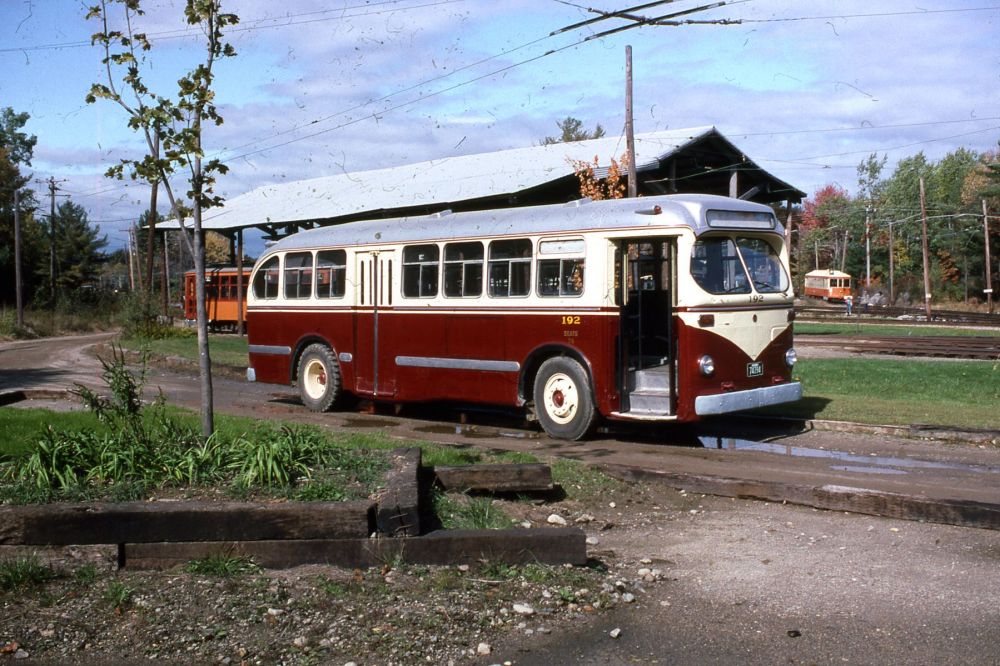
Norman Down
- Builder
- ACF-Brill
- Description
- Model C-36
- Type
- Motor Buses
- Year
- 1948
- Retired from Service
- 1965
- Acquired by the Museum
- 1989
- Note
- No. 192 is stored inside Central carbarn. To operate, it needs a new gas tank.
Middlesex & Boston St. Ry. 192
From Massachusetts
History
The Middlesex & Boston Street Railway served suburbs west of Boston and connected with the Boston Elevated Railway’ streetcar routes into Boston. The M&B replaced its streetcars with buses in 1930. In 1948, the M&B acquired 20 Model C-36 buses from A.C.F.-Brill, numbers 190 – 209. The C-36 buses had a Hall-Scott gasoline motor and an aluminum exterior. The company later acquired 31 additional Model C-36s. No. 192 operated from both the Waltham, MA and Auburndale, MA garages.
ACF-Brill had been formed in a 1944 merger. American Car and Foundry was the country’s largest manufacturer of railroad cars and also made streetcars and interurbans. J.G. Brill had been the largest producer of streetcars and had also produced trolley buses and motor buses. In 1922, ACF ventured into the rubber tired arena with the purchase of Carter Carburetor Corporation. ACF targeted the growing motor coach market and began working with J. G. Brill on acquiring control of Hall-Scott Motor Company, maker of gasoline engines and Fageol Motors, a manufacturer of coach bodies. American Car & Foundry Motors was incorporated in 1925 and controlled Hall-Scott and Fageol Motors. In 1926, the holding company, Brill Corporation, was created to acquire the stock of ACF Motors and J. G. Brill. American Car and Foundry owned 65% of Brill Corporation’s stock. Although controlled by Brill Corporation, ACF Motors and J.G. Brill were not merged together until 1944 to form the ACF-Brill Motors Company. ACF-Brill produced trolley buses and motor buses. The motor buses used Hall-Scott gasoline engines. ACF-Brill became only the fifth largest bus producer. The C-36 bus was one of ACF-Brill’s primary models. ACF-Brill sold 1,546 C-36 buses. In the 1950s, General Motors diesel engine buses took over most of the bus market, and ACF-Brill closed in 1954.
The Boston Elevated Railway and several other suburban Boston operators also purchased fleets of A.C.F.-Brill Model C-36 buses, making this a common vehicle in the Boston area after World War II. In the 1960s, the M&B used No. 192 for rush hour and school trips. By about 1967, the M&B replaced its C-36 buses with diesel buses leased from the Massachusetts Bay Transportation Authority.
When the M&B retired No. 192, Alan Pommer purchased No. 192 for $50 and kept it at his property in Lincoln, NH. In 1989, he donated the bus to Seashore. Seashore, in 1962, had acquired Middlesex & Boston (originally Lexington & Boston) streetcar No. 41. These two vehicles at Seashore are the only preserved M&B vehicles. Soon after arriving, Seashore cleaned and repainted No. 192 in its maroon, cream and silver paint scheme. In 1990, No. 192 participated in both the Old Home Week parade and Main Street 90s event in Kennebunk. At the request of the MBTA, No. 192 also participated in the 1990 Bus Rodeo in Boston which was a competition of bus driver skills.
Technical Information
- Seats: 36
- Engine: Hall-Scott 135
- Tires: 11.00 x 20
Weight and Dimensions
- Length: 30’ 9.00"
- Width: 95.00"
- Height: 9’ 6.00"
© 1998 - 2025 New England Electric Railway Historical Society. All Rights Reserved.